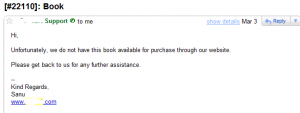Almost every business irrespective of the stage it is in finds itself in a situation where the customer demands/expectations in terms of service,urgency or flexibility are way beyond what you offer. Young businesses find it particularly tough to cope up with customers like these who demand the best of everything and in many cases least willing to pay anything(extra) for these services. Because of the inherent lack of resources(in a young business especially the self-funded/bootstrapped ones) and other reasons the question that occurs is of which customers or their demands to relent to and which ones to let go. All this is despite the fact that nobody wants to lose a customer or an even an order from them.
When such decisive moments occur regularly the business has two(obvious) choices
- Drawing a fine line of what can and what cannot be done(A policy)
- Stretching themselves to accommodate the extra needs/demands of the customers (A policy of not having a policy)
I have an intuition(and some experience too) that most businesses though try for option 2 but settle for option 1 sooner than later. Pragmatically speaking it makes perfect business sense but I feel for some businesses it makes sense to bend a little more and choose option 2. The option to accommodate all the whims and fancies of a customer to the extent of them being unreasonable. Yes, in short “let your customers be unreasonable”. While this might sound unreasonable itself I feel its worth giving a try. The rationale(A bit optimistic and Utopian) behind the same being
- If you offer the kind of services which are really tough to deliver, your value in eyes of the customer is quite likely to get a raise. Do this again and they will set you up a notch up than others in your market and will most likely return to you again and again.
- By wowing the customer you stand great chances of them spreading the word about you. This works particularly well since no competitor of yours would have offered that service to them and you did.
- You test your limits and that of your system
- By accommodating all sorts of customer needs regularly you get some unexpected insights on how to do certain things or how to do them better or even better that of a new/better business Idea.
What do you think?
PS: I was inspired to write this post after our team at Dial-a-Book completed a book delivery around 9:45 PM to a place quite far from our office and home. The customer wanted the book after 9 PM in the night or before 6:30 AM in the morning and we were happy to push our limits 🙂





